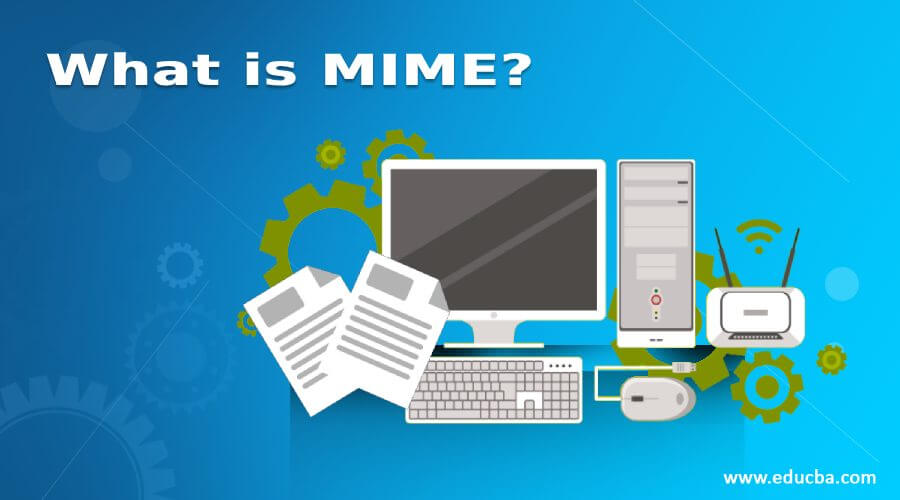Updated April 15, 2023

Introduction to Multipurpose Internet Mail Extension
MIME stands for Multipurpose Internet Mail Extension, is a system extends the basic email system by permitting users to send binary files using the basic email system. Developed to overcome from SMTP protocol, as using SMTP, only text messages can be exchanged. MIME is used to transfer text messages, documents, multimedia files, etc. The MIME email message contains a normal internet text message with some special header and a formatted section of text where each section holds ASCII encoded data. Each section starts with an explanation as to ho the data that follows should be interpreted/decoded at the recipient end. The receiver email system uses this explanation to decode data.
Top MIME Headers
There are 5 headers in MIME which are as follows:
1. MIME version: This header contains the MIME version number. For now, it is reserved for future use.
2. Content-type: This header is used to define the data which is present in the body of the message. content types are text, message, image, video, audio, multicart, and application. Details provided are sufficient so that the receiver email system can properly deal with the received email.
3. Content transfer encoding: This header is used to define transmission type i.e. encoding method used for the body of the messages. There are 5 methods – 7-bit, 8-bit, binary, Base-64, and Quoted-Printable
4. Content ID: This header section defines ID which identifies MIME entities uniquely.
5. Content description: This header section is used when the body of the message cannot be read, for example, image, video.
Functions of MIME
MIME offers the following functions:
1. Signed data: it consists of a message digest encrypted with the private key of the sender. Both content and digital signature are encoded using Base-64.
2. Clear-signed data: It is similar to signed data, the only difference is in clear signed data only digital signature is encoded using Base-64.
3. Enveloped data: It consists of encrypted content of any type, where the key used for encryption is encrypted with the public key of the receiver.
4. Signed and enveloped-data: It combines both signed only and enveloped only entities. We can sign enveloped data or can be enveloped signed data or clear signed data.
MIME security features
5. Signed receipts: It is used as a acknowledge for an original message. In other words, we can say that it is used as proof of delivery of a message to the original sender. Receiver signs the original message which is sent by a user, sender’s signature, and the acknowledgment and creates a MIME message type.
6. Security labels: It is added to a message to identify the access control, priority of the message and its sensitivity (confidential level)
7. Secure Mailing List: It is created to take over the processing which is required per recipient whenever a sender of message sends messages to multiple users. For example, if a message is being sent to 5 recipients, it may have to be encrypted with 5 respective public keys of the recipients. MIME mailing list agent can take a single incoming message, perform the appropriate encryption using a key, and then forward that encrypted one. The sender encrypts the original message only once and sends it only once. The secure Mailing list does the remaining work.
Cryptographic Algorithms Used in MIME
List of cryptographic algorithms used for Multipurpose Internet Mail Extension are as follows:
- Diffie Hellman algorithm: It is used for symmetric key encryption.
- Digital Signature Standard (DSS): It is used for digital signature.
- DES-3: It is used to encrypt the symmetric key.
- RSA: This algorithm is either used to encrypt symmetric key or digital signatures.
For use of algorithms, MIME used two terms, must and should where must specify the use of algorithms compulsory and should specify possible support.
- Message digest: Must support MD5 and SH1, should use SHA-1.
- Enveloping: Sender and receivers must support Diffie-Hellman. sender and receiver should support RSA.
- Digital signature: sender and receiver both must support DSS and should use RSA.
- Symmetric key Encryption: Sender should use DES-3 and RC4 and receiver must use DES-3 and should use RC2.
MIME Certificate
Multipurpose Internet Mail Extension uses an X.509V3 certificate. The key management scheme which is used in MIME is a combination of X.509 certificate hierarchy and web of trust as specified in PGP (Pretty Good Privacy). These certificates are signed by CA only.
List of key management functions used by MIME are as follows:
- Key generations: User which has administrative capabilities should be able to create Diffie Hellman and DSS key pairs and should be able to create RSA key pairs.
- Registration: To receive the X.509 certificate user must register his/her public key to CA.
- Certificate storage and retrieval: To decrypt the incoming message and validate the signature of incoming messages, the user needs a digital certificate. This activity must be maintained by local administrative only.
Conclusion
In this article, we have seen what is MIME, its functions along with Cryptographic algorithms used in MIME. I hope you will find this article helpful.
Recommended Articles
This is a guide to What is MIME?. Here we discuss the Introduction Multipurpose Internet Mail Extension and its types of headers along with functions in brief. You can also go through our other suggested articles to learn more –

